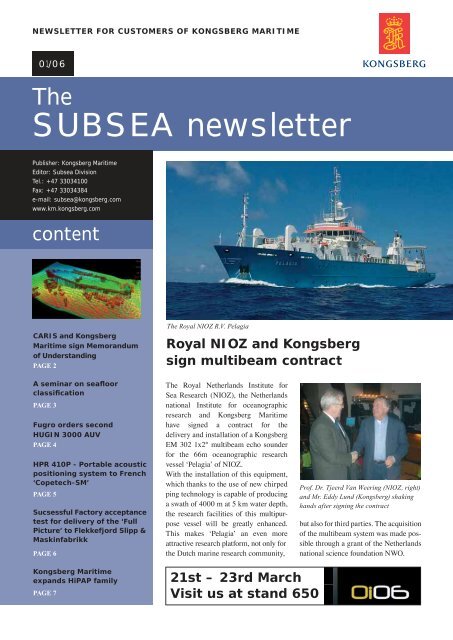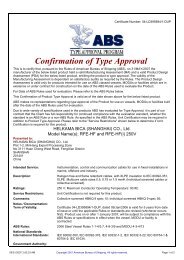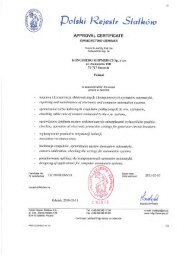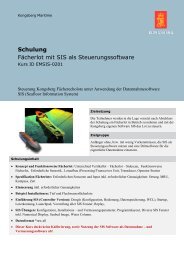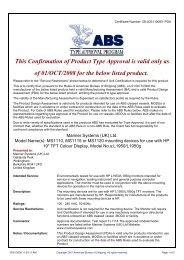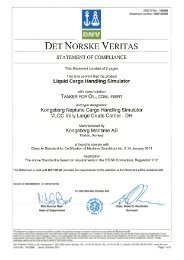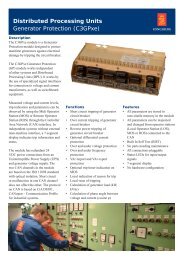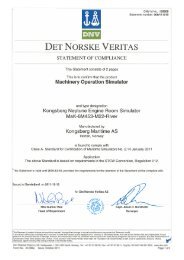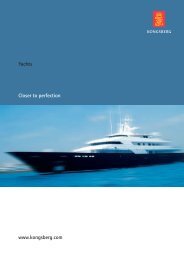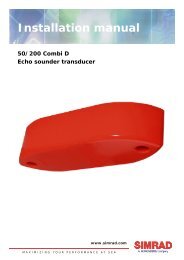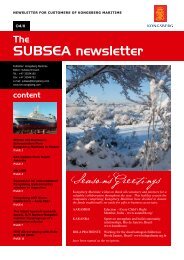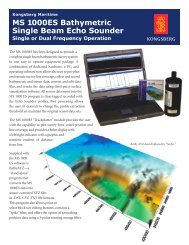March 2006 - Kongsberg Maritime
March 2006 - Kongsberg Maritime
March 2006 - Kongsberg Maritime
You also want an ePaper? Increase the reach of your titles
YUMPU automatically turns print PDFs into web optimized ePapers that Google loves.
NEWSLETTER FOR CUSTOMERS OF KONGSBERG MARITIME<br />
01/06<br />
The<br />
SUBSEA newsletter<br />
Publisher: <strong>Kongsberg</strong> <strong>Maritime</strong><br />
Editor: Subsea Division<br />
Tel.: +47 33034100<br />
Fax: +47 33034384<br />
e-mail: subsea@kongsberg.com<br />
www.km.kongsberg.com<br />
content<br />
CARIS and <strong>Kongsberg</strong><br />
<strong>Maritime</strong> sign Memorandum<br />
of Understanding<br />
PAGE 2<br />
The Royal NIOZ R.V. Pelagia<br />
Royal NIOZ and <strong>Kongsberg</strong><br />
sign multibeam contract<br />
A seminar on seafloor<br />
classification<br />
PAGE 3<br />
Fugro orders second<br />
HUGIN 3000 AUV<br />
PAGE 4<br />
HPR 410P - Portable acoustic<br />
positioning system to French<br />
‘Copetech-SM’<br />
PAGE 5<br />
Sucsessful Factory acceptance<br />
test for delivery of the ‘Full<br />
Picture’ to Flekkefjord Slipp &<br />
Maskinfabrikk<br />
PAGE 6<br />
The Royal Netherlands Institute for<br />
Sea Research (NIOZ), the Netherlands<br />
national Institute for oceanographic<br />
research and <strong>Kongsberg</strong> <strong>Maritime</strong><br />
have signed a contract for the<br />
delivery and installation of a <strong>Kongsberg</strong><br />
EM 302 1x2° multibeam echo sounder<br />
for the 66m oceanographic research<br />
vessel ʻPelagiaʼ of NIOZ.<br />
With the installation of this equipment,<br />
which thanks to the use of new chirped<br />
ping technology is capable of producing<br />
a swath of 4000 m at 5 km water depth,<br />
the research facilities of this multipurpose<br />
vessel will be greatly enhanced.<br />
This makes ʻPelagiaʼ an even more<br />
attractive research platform, not only for<br />
the Dutch marine research community,<br />
Prof. Dr. Tjeerd Van Weering (NIOZ, right)<br />
and Mr. Eddy Lund (<strong>Kongsberg</strong>) shaking<br />
hands after signing the contract<br />
but also for third parties. The acquisition<br />
of the multibeam system was made possible<br />
through a grant of the Netherlands<br />
national science foundation NWO.<br />
<strong>Kongsberg</strong> <strong>Maritime</strong><br />
expands HiPAP family<br />
PAGE 7<br />
21st – 23rd <strong>March</strong><br />
Visit us at stand 650
THE SUBSEA NEWSLETTER PAGE 2<br />
MARCH <strong>2006</strong><br />
CARIS and <strong>Kongsberg</strong> <strong>Maritime</strong> sign Memorandum<br />
of Understanding<br />
CARIS, Canada and <strong>Kongsberg</strong> <strong>Maritime</strong><br />
have signed a memorandum of understanding<br />
to collaborate and deliver<br />
CARIS HIPS/SIPS multibeam processing<br />
software to existing and potential<br />
KONGSBERG clients.<br />
Single off-the-shelf<br />
software product<br />
CARIS HIPS/SIPS represents a single<br />
off-the-shelf software product that<br />
embodies all of the very latest statisticalbased<br />
data cleaning and processing<br />
methodologies currently reshaping the<br />
ocean mapping industry in one single<br />
package. The addition of HIPS/SIPS<br />
to KONGSBERGʼs existing multibeam<br />
processing products appeals to a greater<br />
diversity and variety of end-user needs,<br />
thus strengthening market position.<br />
Ongoing cooperation<br />
As part of this agreement, CARIS will<br />
provide ongoing marketing, sales and<br />
training support for the HIPS/SIPS<br />
software to KONGSBERG engineers<br />
and sales specialists. Further, the two<br />
parties have committed to working<br />
cooperatively on an ongoing basis, to<br />
offer migration from Neptune users to<br />
HIPS/SIPS and to ensure that the technical<br />
needs of KONGSBERG clients<br />
are being met in future planning of the<br />
HIPS/SIPS software.<br />
Independent of data formats<br />
“We are pleased to work with <strong>Kongsberg</strong>,<br />
enabling more multibeam processing<br />
options for their clients,” said Derrick<br />
Peyton, CARIS Marketing and Sales<br />
Manager. “As companies face issues of<br />
large bathymetric data sets, interoperability<br />
and distribution, CARIS multibeam<br />
processing and data management<br />
software supports KONGSBERG clients<br />
with their data cleaning and processing<br />
needs regardless of the data format and<br />
workflow.”<br />
Quality multibeam processing tool<br />
“It is our objective through this<br />
collaboration with CARIS to ensure<br />
<strong>Kongsberg</strong> customer satisfaction by<br />
providing a quality multibeam processing<br />
tool that is well supported to existing<br />
and potential clients. However, our well<br />
known and well tested NEPTUNE post<br />
processing software will still be available<br />
as a choice for the users,” says Freddy<br />
Pøhner, Vice President Sales and Marketing<br />
for <strong>Kongsberg</strong> <strong>Maritime</strong>-Subsea.<br />
About HIPS and SIPS<br />
The HIPS and SIPS product is a comprehensive<br />
bathymetric data cleaning<br />
and validation tool integrated with powerful<br />
vector product creation. HIPS and<br />
SIPS can take the raw sounding data<br />
from ship to chart. Supporting over 40<br />
industry standard sonar data formats,<br />
HIPS and SIPS can easily integrate into<br />
any workflow. Proven automated data<br />
cleaning filters and algorithms assist in<br />
todayʼs high data volume environments.<br />
This, coupled with the ability to easily<br />
produce vector products such as contours<br />
and selected soundings, makes the<br />
software a powerful production tool.<br />
Croon Bakker Combination and <strong>Kongsberg</strong> <strong>Maritime</strong><br />
sign multibeam contracts<br />
Croon Bakker Combination, Netherlands,<br />
has been awarded the contract<br />
for the supply and integration of a<br />
number of systems for the two new<br />
pipe laying vessels ordered at<br />
Merwede shipyard by Subsea 7. The<br />
two vessels will be equipped with an<br />
EM 1002 multibeam echosounder – in<br />
addition to DP, HiPAPs and other<br />
sensors from <strong>Kongsberg</strong> <strong>Maritime</strong>.
THE SUBSEA NEWSLETTER PAGE 3<br />
MARCH <strong>2006</strong><br />
A seminar on seafloor classification<br />
December 1 and 2 2005, <strong>Kongsberg</strong><br />
<strong>Maritime</strong> invited some of the users<br />
of Neptune (later named Neptune-B),<br />
Triton (later named Neptune-C) and<br />
Poseidon (later named Neptune-S) to<br />
Horten for a seminar on seafloor<br />
classification.<br />
The seminar gathered participants from<br />
<strong>Kongsberg</strong> <strong>Maritime</strong>, several customers<br />
using our products, scientists and developers<br />
from research institutions.<br />
The first thing to discuss was how to<br />
use multibeam echosounders as a tool<br />
for seafloor classification. Kjell Nilsen<br />
from <strong>Kongsberg</strong> <strong>Maritime</strong> gave an<br />
overview of the acoustic principles of<br />
multibeam echosounders and the ongoing<br />
development in Horten. Terje<br />
Pedersen (KM) presented the state<br />
of Neptune-B, -C and -S and the road<br />
ahead for the product was discussed.<br />
The new classification tool for Kongeberg<br />
single beam echosounders was demonstrated<br />
by T. T. Lied (KM). This tool,<br />
SeaBec, can take advantage of serveral<br />
frequencies to classify the seafloor. The<br />
results are available immediately in<br />
the geographical display and there are<br />
several options to control the operation<br />
of SeaBec.<br />
The seminar also contained papers from<br />
the participants. Professor J. M. Hovem<br />
presented a paper on how to use scattering<br />
theory in seafloor classification,<br />
M. A. Larsen presented his method for<br />
seafloor classification, R. Riethmuller<br />
presented results from seafloor classification<br />
using EM 3002 and ways to<br />
improve the system. M. Roche and K.<br />
Degrendele presented results from using<br />
Neptune-C and suggested tools to<br />
help the users make better use of the<br />
output from Neptune-C. T. Thorsnes<br />
presented a paper on how to use seafloor<br />
classification in the MAREANO<br />
project and needs for improvements in<br />
hardware and software. D. Simons and<br />
T. Driesenaar presented a seafloor classification<br />
system developed by TNO.<br />
Valuable contacts were made during<br />
the following discussions. The users of<br />
Neptune have over the years gathered<br />
vast experience in the use of seafloor<br />
classification, and the joint cooperation<br />
between the users, and between the<br />
users and scientists, will help the<br />
development of seafloor classification<br />
tools in the future.<br />
As a result of this seminar, new<br />
versions of Neptune-B, -C and -S are<br />
made available that we hope will help<br />
the users to make better use of the<br />
classification done in Neptune-C.<br />
Pipe-surveys in the North Sea<br />
Over the past year, the EM 3002 has<br />
been run on several pipe-surveys in<br />
the North Sea, by Stolt Offshore, now<br />
Acergy.<br />
The performance of the system has<br />
been documented and the EM 3002<br />
has been verified to be an important<br />
tool for inspecting gas and oil-pipes.<br />
The system has also been tested<br />
by Geoconsult on a new coated 8”<br />
pipe with good results. The system<br />
was tracking and displaying the<br />
pipe without any problems when the<br />
pipe was on support legs, and on the<br />
seabed without support legs.
THE SUBSEA NEWSLETTER PAGE 4<br />
MARCH <strong>2006</strong><br />
Fugro orders second HUGIN 3000 AUV<br />
commissioning of the system. This<br />
team draws from key staff involved in<br />
previous AUV, ROV and geophysical<br />
survey operations and has proven to<br />
be an exceptional combination. The<br />
integrated, multi-disciplinary approach<br />
ensures maximum efficiency and effectiveness<br />
based on the broadest range of<br />
skills, knowledge and experience.<br />
HUGIN AUVs have, since their market<br />
introduction in 1997, successfully been<br />
used for civilian and military applications.<br />
More than 60.000 km of accumulated survey<br />
world wide for the Offshore Oil & Gas<br />
industry is achieved with the HUGIN 3000<br />
class AUVs, in the range from shallow and<br />
down to 3000 meter water depth.<br />
Following the successful deployment of<br />
Fugroʼs Echo Surveyor HUGIN 3000<br />
Autonomous Underwater Vehicle (AUV)<br />
in 2005, Fugro NV, in the Netherlands,<br />
has placed an order with <strong>Kongsberg</strong><br />
<strong>Maritime</strong> for the purchase of a second<br />
deep water HUGIN 3000 AUV.<br />
The new build HUGIN 3000 will<br />
be equipped to the same standard as<br />
Echo Surveyor. It will also incorporate<br />
the modifications that were already<br />
made to the Echo Surveyor to enhance<br />
operational efficiency, improve safety<br />
and environmental performance to meet<br />
Fugroʼs requirements.<br />
The new build HUGIN 3000 will be<br />
delivered and tested during winter <strong>2006</strong><br />
and will be ready for operation before<br />
the end of the year. Fugroʼs dedicated<br />
specialist AUV team will again work<br />
with <strong>Kongsberg</strong> <strong>Maritime</strong> over the<br />
next few months during the build and<br />
Due to its unique semi fuel cell battery<br />
technology the vehicles are repeatedly<br />
running survey missions with up to 60<br />
hours endurance with all payload<br />
sensors in operation simultaneously.<br />
Such sensors comprise Side Scan Sonar,<br />
Sub Bottom Penetration Sonar, Multi<br />
Beam Echosounder, and sensors for<br />
measuring conductivity, temperature<br />
and depth. The superior vehicle<br />
control and navigation systems allow<br />
the vehicle to be safely operated in<br />
rough terrain and with high position<br />
accuracy in very deep water.<br />
EA 400SP Splash proof<br />
Early in 2005 we introduced an improved<br />
EA 400 portable and splash<br />
proof echo sounder. Recently we have<br />
also released new software for the EA<br />
400/SP/600, providing new features<br />
and possibilities.<br />
The EA 400SP is a dual frequency<br />
echo sounder operated with a rugged<br />
notebook PC (Tablet PC Edition).<br />
38/200kHz frequency is the standard<br />
configuration - vertical or side looking<br />
transducer(s), powered with 12VDC.<br />
It is easy to commission and therefore<br />
perfect for surveying in shallow water<br />
depth in small and open boats. The new<br />
EA 400 and EA 600 software, has been<br />
improved with several new features,<br />
such as side enhanced looking imaging,<br />
replay function and new data formats.<br />
The EA has for a long time featured the<br />
possibility for side looking imaging, a<br />
feature already popular with users. The<br />
new side looking software has been improved<br />
by scrolling the image vertically<br />
and exporting of georef data on the network<br />
(position and across distance to<br />
an object). For correct across distance,<br />
a vertical transducer must be installed.<br />
Other enhancements includes:<br />
• New functionality in the replay<br />
dialog box (slider and storing of<br />
existing raw file)<br />
• XYZ values in ascii format<br />
(interpolated depth) stored to HD<br />
• Remote control of start and stop<br />
logging/ pinging and history file<br />
• Extended function to detect second<br />
hard bottom with the lowest frequency<br />
in the system. Needed frequencies<br />
e.g. 38/200kHz.
THE SUBSEA NEWSLETTER PAGE 5<br />
MARCH <strong>2006</strong><br />
The Hydrographic Institute - Split and <strong>Kongsberg</strong><br />
<strong>Maritime</strong> sign multibeam contract in January<br />
HPR 410P - Portable acoustic positioning system to<br />
French ‘Copetech-SM’<br />
‘Copetech-SM’ is a French company<br />
specializing in survey missions and<br />
submarine inspection by ROV to<br />
1000m depth. Their brand new <strong>Kongsberg</strong><br />
HPR 410P is now onboard their<br />
new Deep-Sea Survey Unit 1000.<br />
This autonomous unit was especially<br />
designed for deep-sea ROV diving. Its<br />
principal missions are assistance to oil<br />
& gas submarine works. The unit is<br />
easily movable on any floating support<br />
vessel which can accept a 20 feet long<br />
container. ‘Coptech-SM’ is present<br />
in France, French territories and<br />
The Hydrographic Institute of the Republic<br />
of Croatia (www.hhi.hr) and<br />
<strong>Kongsberg</strong> <strong>Maritime</strong> have signed a contract<br />
for the delivery and installation of<br />
an EM 3002D multibeam echosounder<br />
for the 22m long survey vessel RV<br />
ʻHIDRAʼ.<br />
The vessel carries out multidisciplinary<br />
ocean surveys mostly to ensure safe<br />
navigation.<br />
“With the new Multibeam system the<br />
Institute is well prepared to serve different<br />
environments looking for detailed<br />
information about the seafloor,”<br />
says Dr.sc. Zvonko Grzetic, director of<br />
the Institute.<br />
especially in the French Antillas with a<br />
dedicated office for South America.<br />
For more information:<br />
www.copetechsm.fr<br />
HUGIN record-breaking mission<br />
Tuesday evening, 27 December 2005,<br />
HUGIN was recovered after a recordbreaking<br />
mission.<br />
Mission 91 lasted for more than 66<br />
hours, with Hugin covering a distance<br />
of 430 km. This was performed with<br />
water depths in the range of 400 to<br />
1050 meters, in very challenging<br />
terrain and partially on flat seabed.<br />
The mission plan included nearly 500<br />
waypoints, where approx. 50 waypoints<br />
were changed via acoustic link<br />
during the execution of the mission.<br />
Payload logged was Simrad EM 2000<br />
150° multi-beam echo-sounder, Edgetech<br />
FS AU SSS/SBP, dig quartz<br />
2000m depth sensor and FSI<br />
2”MCTD sensor.
THE SUBSEA NEWSLETTER PAGE 6<br />
MARCH <strong>2006</strong><br />
Sucsessful Factory acceptance test for delivery of the<br />
‘Full Picture’ to Flekkefjord Slipp & Maskinfabrikk<br />
Britainʼs leading environmental<br />
research organization has commissioned<br />
Flekkefjord Slipp & Maskinfabrikk<br />
to build a state-of-the art scientific<br />
research ship to replace the RRS Charles<br />
Darwin. The RRS Charles Darwin has<br />
been supporting researchers since 1985<br />
and is now coming to the end of its<br />
working life.<br />
The 5,000 tonne ship, the James Cook,<br />
will operate worldwide - from the tropics<br />
to the edge of the ice sheets - enabling<br />
cutting edge scientific research.<br />
The shipʼs design will enable it to work<br />
in higher sea-states than the Research<br />
Councilʼs other dedicated research vessels.<br />
It will be more manoeuvrable, have<br />
more scientific berths, and better technical<br />
facilities.<br />
Chief Executive of the Natural Environment<br />
Research Council, Professor John<br />
Lawton explains why this new ship is<br />
essential. “We need year-round access<br />
to dedicated research ships for the foreseeable<br />
future. The James Cook will<br />
help answer the biggest environmental<br />
questions facing us in the next century:<br />
in climate change, evolution, ocean circulation<br />
and biodiversity. The research it undertakes<br />
will have an impact on all of us.”<br />
The ship will be operated by NERCʼs<br />
Research Ship Unit based at Southampton<br />
Oceanography Centre. Chairman of<br />
the procurement board for the new ship,<br />
and director of the centre is Professor<br />
Howard Roe.<br />
The ship will be completed summer<br />
<strong>2006</strong> and the following equipment<br />
FROM LEFT: Edward Cooper, Project Liaison Offi cer NERC, Rune Olsen, Over all project<br />
manager, Tore Nilsson, test engineer, Raymond Halvorsen, technician test , Sigbjørn Sirnes,<br />
Project Manager Flekkefjor Slipp & Maskinfabrikk<br />
was tested during FAT in Horten 2-3<br />
<strong>March</strong>:<br />
Multibeam echosounders:<br />
• EM 120 1X1 degree system<br />
• EM 710 2X2 degree system<br />
Sub bottom profiler:<br />
• SBP 3X3 degree system, using<br />
EM 120 RX transducer and electron<br />
ics for receive of signals.<br />
Single beam Hydrography<br />
echosounder:<br />
• EA 600 12Khz<br />
Split beam Fishery Recearch<br />
echo sounder:<br />
• EK60 18,38,70,120 and 200 Khz<br />
Synchronization unit:<br />
• SSU for synchronization of EM 120,<br />
SBP, EM 710, EA 600, EK60,<br />
ADCP75and ADCP150<br />
Marine Data Management system:<br />
• MDM 400<br />
The following equipment was tested<br />
during FAT in <strong>Kongsberg</strong> 8-9 <strong>March</strong>:<br />
Alarm and monitoring system:<br />
• SVC400 with approx. 1000 I/Oʼs<br />
DP and joystick system:<br />
• SDP 11<br />
• cJoy<br />
In addition, <strong>Kongsberg</strong> <strong>Maritime</strong> has<br />
delivered a complete navigation package<br />
with bridge consoles.<br />
This is close to what we call “The Full<br />
Picture”<br />
KOG - wins MNOK 15 contract with the US Navy<br />
<strong>Kongsberg</strong> <strong>Maritime</strong>ʼs US subsidiary,<br />
<strong>Kongsberg</strong> Underwater Technology<br />
Inc., has signed a MNOK 15 contract<br />
to provide several integrated sonar and<br />
echo sounder systems to the US Navy.<br />
The contract also includes four years of<br />
options with a potential total value of<br />
appr. MNOK 190.<br />
These systems are designed for permanent<br />
installation aboard the six T-AGS<br />
60 class survey vessels operated by<br />
the US Naval Oceanographic Office<br />
(NAVOCEANO).<br />
The contract covers a five-year period,<br />
meaning that if all options are exercised,<br />
it will continue until February<br />
2011. The contract encompasses design,<br />
manufacture, testing, integration,<br />
installation and overall support for the<br />
new systems.
THE SUBSEA NEWSLETTER PAGE 7<br />
MARCH <strong>2006</strong><br />
<strong>Kongsberg</strong> <strong>Maritime</strong> expands HiPAP Family<br />
<strong>Kongsberg</strong> <strong>Maritime</strong> will unveil two<br />
new members of its highly regarded<br />
HiPAP® underwater positioning system<br />
family at Oi06.<br />
HiPAP Goes Portable<br />
HiPAP 350P is the only automatic beam<br />
steering portable transducer on the market<br />
and is an ideal tool for the ʻVessel<br />
of Opportunityʼ due to its ease of transport<br />
and set-up. With its new, unique<br />
and compact transducer accompanied<br />
by a built-in accurate Motion Reference<br />
Unit, HiPAP 350P can be used on almost<br />
any vessel at short notice.<br />
The transducer is designed to be mounted<br />
on a shaft to be installed over-theside<br />
or through a moon-pool of a vessel.<br />
With its 345 mm diameter transducer<br />
head, it can also penetrate all existing<br />
12 inch / 350 mm gate valves.<br />
The system uses unique narrow pointing<br />
beam technology, to minimise the<br />
effect of noise from noise sources such<br />
as propellers and thrusters. The 46-element<br />
transducer creates a narrow beam<br />
of +/- 7,5 degrees, which can be pointed<br />
towards the transponder(s) in any direction<br />
within a 120-degree cone below the<br />
vessel.<br />
The operational area can easily be extended<br />
or changed by simply mounting<br />
the transducer on a tilted bracket,<br />
facing the sector to the wanted area.<br />
There is no need for extra calibration,<br />
or mechanical fine adjustments, as the<br />
internal Motion Reference Unit will automatically<br />
compensate for the tilt.<br />
New Low Frequency HiPAP<br />
HiPAP 100 is the new and Low Frequency<br />
member of the HiPAP® system<br />
family. With high accuracy, good<br />
repeatability and high reliability, the<br />
HiPAP 100 system is the multi-purpose<br />
acoustic positioning system for ultra<br />
deep water operations.<br />
The HIPAP 100 system is supplied<br />
as an ʻultra deep waterʼ version using<br />
transponders for high water pressure.<br />
Transponders with depth rating down to<br />
6500 m are available. The HIPAP 100<br />
is well proven, and it provides the simplest<br />
way to position ROVs and other<br />
objects in very deep water.<br />
The beam forming, signal detection and<br />
digital signal processing are based on<br />
the same principles as the other well<br />
proven HiPAP family members. The elements<br />
are all computer-controlled and<br />
the system will dynamically control<br />
a narrow listening beam towards the<br />
transponder(s), minimising the noise<br />
influence from the vesselʼs thrusters<br />
and propellers.<br />
About HiPAP<br />
HiPAP was first developed with the focus<br />
of using the Super Short Base Line<br />
(SSBL) principle, as the market requirement<br />
was to try to avoid the Long Base<br />
Line (LBL) principle in deep water accurate<br />
seabed survey applications.<br />
The main advantage of the SSBL principle<br />
is that it only requires installation of<br />
one vessel-mounted transducer and one<br />
subsea transponder. The unique transducer<br />
technology along with advanced<br />
digital signal processing of HiPAP has<br />
been proven to obtain optimal position<br />
accuracy. The HiPAP series of transducers<br />
features many more elements<br />
than any of its competitors. This provides<br />
increased acoustical redundancy,<br />
mathematical redundancy and improvement<br />
of the Signal to Noise level.<br />
All HiPAP systems can now also install<br />
a Long Base Line functionality providing<br />
the operator flexibility when this is<br />
required. All HiPAP systems use the<br />
same Acoustic Positioning Operating<br />
System (APOS) and Man Machine interface.<br />
The APOS consists of a Color<br />
Display, an Acoustic Positioning Computer<br />
(APC), Keyboard and tracker-ball.<br />
Delivery of EM 3002<br />
Bakker Sliedrecht Electro Industrie B.V.<br />
and <strong>Kongsberg</strong> <strong>Maritime</strong> signed a contract<br />
for the delivery of EM 3002 to two<br />
new vessels to be built for the Swedish<br />
coastguard. The two multibeam echosounders<br />
are a small part of a total package to be<br />
supplied by <strong>Kongsberg</strong> <strong>Maritime</strong>.


